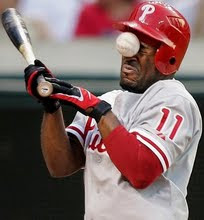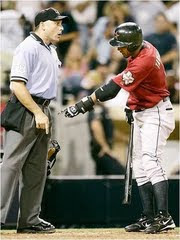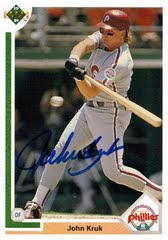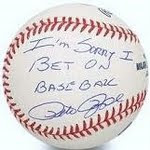Larry Walker was a great player, but he does not get the proper level of respect because his career falls in that grey area between “the best” and “excellent for really long time.” Larry Walker was neither Sandy Koufax-esque (burning brightest briefly), Pujolsian (truly one of the most elite ever), and certainly he did not stick around for 20+ years (although a fifteen-plus year major league career is nothing to sneeze at). Position differences aside (WAR accounts for that), Walker’s value and case reminds me a lot of Ron Santo with the off-the-field baggage. Nonetheless, Larry Walker's numbers stack up and are Hall of Fame worthy.
With two standout seasons (1997 and 2001) mixed amongst with many great ones, Walker falls much closer to the Moliter side of the Hall (excellent duration) than the Ted Williams (best of the best) or Sandy Kofaux (brightest briefly) side. Per Fangraphs, Walker logged seven seasons with 5+ WAR and ten seasons of 4+ WAR. Larry Walker only posted sub-3 WAR campaigns in a four seasons: 1989 [-0.1 WAR], when he received less than 60 trips to the plate in his first major league cup of tea; 1995 (+1.3 WAR), when he only played 83 games; 2000 (+2.0 WAR), when he only played 87 games; and 2005 (+2.6 WAR), when he only played 100 games. If we're being honest, Walker only had three sub-3 WAR campaigns, and they came in partial seasons where his full season pace was above the 3 WAR threshold. Larry Walker's career WAR per 650 PA is 5.9.
Going back to the Paul Molitor and Carlton Fisk analogy…

…Fangraphs’ WAR data shows him comfortably sandwiched in value between the two. He lasted fewer season than either Molitor or Fisk, but Walker had two better single seasons (1997 and 2001) than either Molitor or Fisk ever had.
More telling, perhaps, is a WAR comparison to three recent Hall of Fame inductees (although one was a second baseman):

Notice that Walker is close in value to the group for the majority of his career, edging the group out in 10 of 17 seasons (he also had the two single best seasons of the group).
If you want to be slightly more scientific, let's consult the Sabermetrician's check list:
- Does he walk a lot? 11.4% career walk rate.
- Does he hit for power? .252 career isolated power (ISO) and 383 career home runs.
- How did he fair against the rest of the league? Career .414 wOBA, 142 wRC+.
- If he stole bases, was he efficient? Career success rate slightly above 75%, so sure.
- Did he play for an obscure franchise that Jonah Keri can rally around? Five-plus year tenured Expo!
First and foremost, 383 home runs may not seem a lot by today's standards, but it is still top 70 in the history of baseball. Only 11 players in the history of the game have more home runs and more stolen bases than Larry Walker, who was a pretty good baserunner. Fangraphs only tracks relative baserunning from 2002 and beyond, but even then, in the "twilight" of his career, Walker’s baserunning added an extra 10 runs over the final 461 games of his career.
Second, while Coors may have inflated Walker's numbers, when park factors and relative league production is accounted for, Walker was still 42% better than the league average player at the time. His career wOBA is a superb .414. To put this relative career production in perspective, note that less than 35 qualified players own a career wOBA that is 50% better than their peers. Note further that of those 34 players, a handful are currently active players. A 142 wRC+ narrowly places Larry Walker in the top 55 to 60 range in terms of relative career production in the history of retired ballplayers.
In short, Larry Walker, with 73 WAR to his name, deserves a spot in Cooperstown. Jeff Bagwell may be more deserving, but that argument is for another day.







0 comments:
Post a Comment